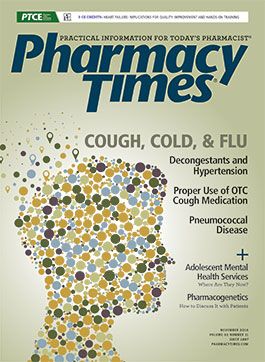Publication
Article
Pharmacy Times
Decongestants and Hypertension: Dangerous Together
Author(s):
Nearly 33% of adults in the United States have the typically symptomless disease known as hypertension.
Nearly 33% of adults in the United States have the typically symptomless disease known as “hypertension.”1 When health care providers treat ailments in these individuals, caution should be exercised, as several medications are contraindicated. For example, because decongestants, which are frequently used to manage nasal congestion, can increase blood pressure (BP), their use is a concern in patients with hypertension.
Nasal congestion, often referred to as a “stuffy nose,” is a typical symptom of the common cold, occurring when nasal and adjacent tissues and blood vessels become swollen with excess fluid.2 This symptom has been described as the most bothersome by adults with allergies.2,3 Individuals with nasal congestion are encouraged to drink plenty of fluids to thin mucus and promote nasal drainage. Getting plenty of rest and limiting activities are also warranted for affected patients.4 In addition, OTC medications are often used to manage symptoms; however, they do not shorten the duration of illness and only offer temporary relief.
Individuals with hypertension should be made aware that decongestants can elevate their BP. Various medical guidelines characterize hypertension in adults as a systolic BP of 140 mm Hg or higher or a diastolic BP of 90 mm Hg or higher.5 Hypertension is treated by using various methods to decrease BP to a predetermined target. The American Heart Association warns all individuals with hypertension, including those being treated for it, to read the labels on all OTC medications prior to use.6
Decongestants
Nasal decongestants are vasoconstrictors that belong to the pharmacologic class sympathomimetic amines. They exert their primary action by activating alpha-adrenergic receptors on blood vessels of the nasal mucosa. This results in vasoconstriction, which decreases blood flow through the nasal mucosa and shrinks tissue.7 Decongestants are available in multiple formulations with varying degrees of systemic effects, including potential elevation of BP.
Oral Decongestants
The decongestants pseudoephedrine and phenylephrine may offer mild relief from nasal congestion associated with the common cold.8 These medications are administered alone or in combination with antihistamines, which minimize other symptoms associated with the common cold.
Pseudoephedrine is a common ingredient in more than 135 medications and has proved effective in treating nasal congestion. The drug was found to elevate BP in a 2005 meta-analysis that showed it significantly increased systolic BP (0.99 mm Hg) and heart rate (2.83 beats/min). However, the results revealed no effect on diastolic BP. Higher BP increases were associated with higher doses and immediate-release formulations of pseudoephedrine.9
Studies comparing phenylephrine with placebo showed no significant improvement in measures of nasal congestion. There is a lack of data on phenylephrine’s effect on BP.
Phenylephrine and pseudoephedrine have been described as safe and effective for treating nasal congestion.9 However, as a result of the Combat Methamphetamine Epidemic Act of 2005, pseudoephedrine products are kept “behind the counter” and have certain restrictions regarding their purchase.
Topical Decongestants
Naphazoline, oxymetazoline, and phenylephrine are commonly used topical decongestants. Although these agents are expected to promote local activity, the FDA requires their instructions to contain a warning for individuals with high BP; however, the data on the connection between their use and hypertension are sparse. Unlike other topical decongestants, propylhexedrine is a topical OTC decongestant that is not required to carry a warning against unsupervised use in patients with hypertension.10 The use of topical nasal decongestants for more than 5 days is associated with the development of rhinitis medicamentosa, also known as “rebound rhinitis,” which can lead to user dependency.11
Alternatives
A 2003 Cochrane review concluded that monotherapy with antihistamines does not alleviate nasal congestion to a clinically significant degree. In that review, first-generation antihistamines were found to have greater adverse effects than placebo, with neither first- nor second-generation antihistamines increasing BP. Antihistamines can be used in combination with decongestants; however, they should not be used in small children.8
Saline has been used to relieve congestion and is thought to thin mucus in the sinus cavities. Increasing humidity in the environment of patients with nasal congestion may also provide relief; therefore, the use of humidifiers is recommended. A third solution, nasal strips may help open the nostrils and, therefore, improve breathing in patients with congestion.11
The Pharmacist’s Role
With their training in OTC medications, pharmacists can play a major role in managing decongestion in their patients. No product can be recommended to provide safe and effective relief of congestion in all patients with hypertension. Therefore, pharmacists’ medication knowledge, coupled with their keen ability to obtain valuable information from patients, can ensure optimal drug selection for individuals with hypertension.
Clarence D. Moore, PharmD, BCPS, BCOP, is Assistant Professor at Bernard J. Dunn School of Pharmacy, Shenandoah University, in Ashburn, Virginia.
References
- Mozaffarian D, Benjamin EJ, Go AS, et al; American Heart Association Statistics Committee; Stroke Statistics Subcommittee. Heart disease and stroke statistics—2016 update: a report from the American Heart Association. Circulation. 2016;133(4):e38-e360. doi: 10.1161/CIR.0000000000000350.
- Naclerio RM, Bachert C, Baraniuk JN. Pathophysiology of nasal congestion. Int J Gen Med. 2010:3:47-57.
- Kiefer D, Cherney K. Decongestants to treat allergy symptoms. Healthline website. healthline.com/health/allergies/decongestants#3. Published March 11, 2016. Accessed September 12, 2016.
- Sakethoo K, Januszkiewicz A, Sackner MA. Effects of drinking hot water, cold water, and chicken soup on nasal mucus velocity and nasal airflow resistance. Chest. 1978;74(4):408-410.
- Carretero OA, Oparil A. Essential hypertention, part I: definition and etiology. Circulation. 2000;101(3):329-335.
- American Heart Association (AHA). Over-the-counter medications. AHA website. heart.org/HEARTORG/Conditions/HighBloodPressure/PreventionTreatmentofHighBloodPressure/Over-the-Counter-Medications_UCM_303245_Article.jsp#.V-v0GtArLwe. Accessed September 13, 2016.
- Johnson DA, Hricik JG. The pharmacology of alpha-adrenergic decongestants. Pharmacotherapy. 1993;13(6 pt 2):110S-115S; discussion 143S-146S.
- Taverner D, Latte J. Nasal decongestants for the common cold. Cochrane Database Syst Rev. 2007;(1):CD001953.
- Horak F, Zieglmayer P, Zieglmayer R, et al. A placebo-controlled study of the nasal decongestant effect of phenylephrine and pseudoephedrine in the Vienna Challenge Chamber. Ann Allergy Asthma Immunol. 2009;102(2):116-120. doi: 10.1016/S1081-1206(10)60240-2.
- Herring CT, Maryansky K, Trivette K, Hemberg N. Decongestant use in hypertension. US Pharm. 2006;7:80-88.
- WS Pray, JJ Pray. Safe use of nasal decongestants. US Pharm. 2004;29(7).

Newsletter
Stay informed on drug updates, treatment guidelines, and pharmacy practice trends—subscribe to Pharmacy Times for weekly clinical insights.






